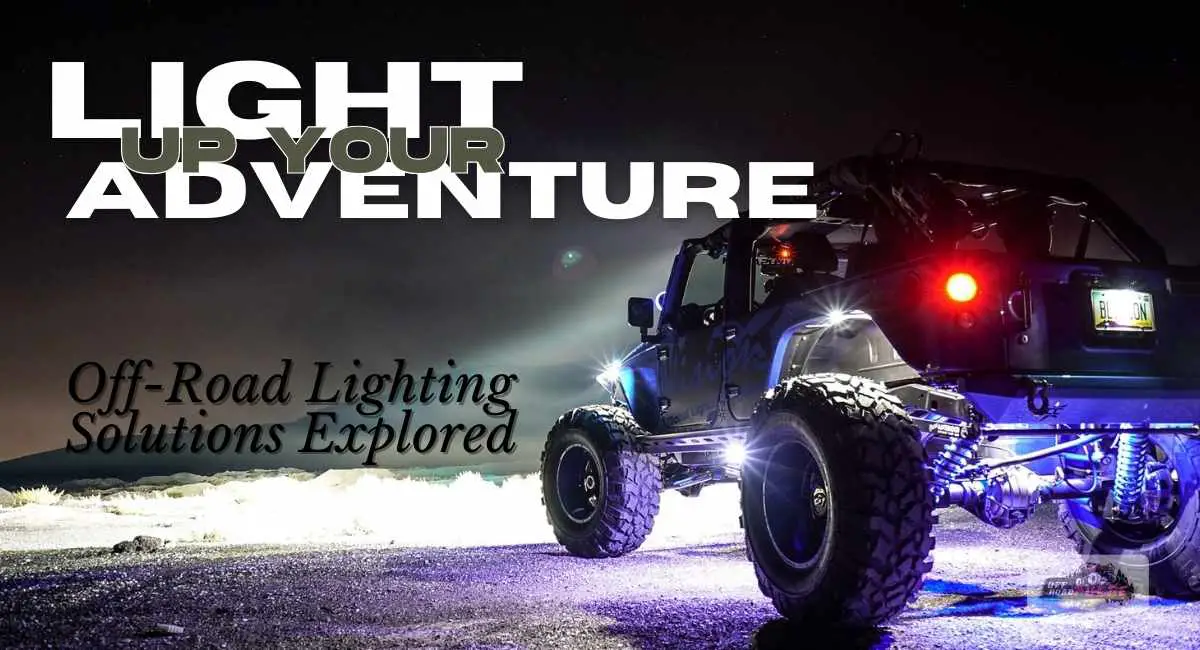The excitement of cruising through rough terrains, splashing in mud, and tackling tricky slopes is undeniably a key appeal for off-road enthusiasts. But as the sun sets and the off-road trails plunge into darkness, the need for proper lighting becomes necessary.
Late-night adventures add a whole new layer of thrill, but without the right lighting, it can quickly turn into a challenging endeavor. Furthermore, navigating through the twists and turns and enjoying the wild beauty of the outdoors after sunset becomes a whole lot safer and more enjoyable with the right illumination.
With that in mind, let’s explore off-road lighting solutions and how they can make your off-roading nights as bright and awesome as daytime.
Importance of Off-Road Lighting
Having proper lighting isn’t just about making your vehicle look cool -though it does. Off-road lighting is a crucial accessory that helps turn the uncertainties of off-roading into a secure adventure while allowing you to shine a light on the awesome things you discover along the way.
Furthermore, off-road driving brings with it the challenge of navigating through diverse terrains—rocky trails, muddy paths, and uneven landscapes. Effective off-road lighting helps illuminate the way and allows drivers to anticipate and overcome obstacles that might otherwise be hidden in the shadows.
Safety is paramount in any off-road adventure, especially when the trails become cloaked in darkness. Proper lighting ensures that hazards, such as rocks, ditches, or wildlife, are visible, giving drivers the crucial seconds they need to react and avoid accidents.
Limited visibility is a common hurdle in off-road environments. Quality off-road lights are designed to cut through the darkness and provide a clear line of sight. This not only enhances safety but also contributes to a more confident and enjoyable off-road experience.
With the right off-road lighting setup, the adventure doesn’t have to end when the sun goes down. High-performance lights allow off-road enthusiasts to extend their explorations into the night while allowing them to discover new trails and enjoy the wilderness after dusk.
Beyond functionality, off-road lighting lets drivers personalize their vehicles to their liking. Ideally, off-road lighting comes in a variety of lighting options, which not only serve practical purposes but also add a distinctive aesthetic appeal to off-road rigs.

Types of Off-Road Lights
Every seasoned off-roader understands that the standard beams from stock headlights won’t cut it. To conquer the darkness of off-road trails, off-roaders often turn to specialized lighting accessories for more power and versatility. Let’s go through some of the off-roading lighting solutions available and how they enhance your off-road experience.
Halogen Lights
Halogen off-road lights are a type of illumination system that utilizes halogen gas to produce light. These lights are commonly used in off-road vehicles to enhance visibility during nighttime and challenging terrains. Halogen lights are often affordable, making them a popular choice among off-road enthusiasts operating on a budget or those who explore sporadically.
Advantages
- Halogen lights are cost-effective, meaning they are accessible to a wider range of off-road enthusiasts.
- The ease of finding replacement bulbs ensures convenient maintenance and accessibility.
- Halogen lights are well-suited for off-road scenarios that do not demand highly focused lighting.
Disadvantages
- Halogen lights fall short in terms of light output compared to more advanced technologies. The illumination provided by halogen bulbs may not be as intense, which might impact visibility in low-light off-road environments.
- Halogen lights are known for being the least energy-efficient among the common off-road lighting options. These lights often consume more power compared to alternatives.
- The light beam produced by halogen lights lacks the precision and sharpness required in off-roading. This may limit their suitability for applications that require focused lighting.
LED Lights
LED off-road lights, just as the name suggests, utilize Light Emitting Diodes (LEDs) to produce bright and efficient light. These lights have gained immense popularity in the off-road community for their energy efficiency, durability, and versatile design.
Advantages
- LED lights use only a fraction of the energy consumed by halogen bulbs. This results in reduced strain on the vehicle’s electrical system and extended battery life.
- LEDs are known for their robustness and resistance to shocks and vibrations, which ensures longevity in off-road conditions.
- LED lights are compact and can be designed in various shapes and sizes. This, in turn, offers flexibility in installation and customization.
- LED lights illuminate instantly without the warm-up time, thus ensuring immediate visibility.
Disadvantages
- LED lights may have a higher initial cost compared to traditional halogen lights, although the long-term benefits often outweigh the cost.
- Professional installation is often recommended to maximize the benefits of LED lights and prevent premature burnout.
- LEDs are sensitive to excessive heat, so proper ventilation is essential to maintain optimal performance.
HID Headlights
HID is a type of lighting that utilizes High Intensity Discharge (HID) technology to provide illumination. These lights function by bypassing an electric charge through a gas-filled bulb, producing an intense, high-output light that is characterized by its remarkable illuminating capabilities.
Advantages
- The standout feature of HID lights is their ability to deliver powerful and far-reaching illumination. This makes them well-suited for high-speed off-road driving at night.
- HID lights come in various color temperatures, allowing users to tailor the lighting to their preferred warmth or coolness.
- HID lights often have a longer lifespan compared to traditional lights.
Disadvantages
- HID lights are considerably costly.
- HID lights require a short warm-up time before reaching their full brightness.
- Much like LEDs, these lights require professional installation.
Placement and Installation of Off-Road Lights
Optimizing the placement and installation of off-road lights is crucial to ensure maximum effectiveness and safety during your nighttime off-roading. Ideally, the choice of mounting location typically depends on the type of light you are adding to your vehicle. Off-road lights come in several forms, but the primary ones include;
I. Light Bars
Light bars are designed to produce far-reaching beam patterns, which provide a combination of long-distance illumination and peripheral visibility. The light bars are available in linear or curved designs to provide flexible beam patterns and mounting options.
Light bars can be mounted on different parts of the vehicle, including the roof, bumper, grille, or even on auxiliary mounts. This versatility enables users to customize the placement of the lighting based on their specific needs.
II. Flood Lights
Flood lights are engineered to produce a wide beam pattern to illuminate the surroundings with a broad and even distribution of light. The primary focus of flood lights is to provide immediate visibility, making them suitable for short to medium-range illumination.
Flood lights are best positioned low on the front bumper to illuminate the immediate area in front of the vehicle. This placement helps enhance visibility in challenging off-road conditions such as mud and dense vegetation.
III. Fog Lights
Fog lights are specialized off-road lights designed to improve visibility in foggy or low-visibility conditions. Fog lights offer a wide and low beam pattern that is aimed towards the ground to help reduce glare and reflection from the fog.
The unique beam pattern of fog lights allows them to cut through the fog and provide better visibility of the road or trail. Fog lights are typically mounted low on the front bumper to maximize their effectiveness in low-lying fog and mist.
IV. Spot Lights
Spotlights are designed to create a narrow and concentrated beam pattern, which directs light to a specific area ahead of the vehicle. These lights are characterized by their ability to project light over significant distances, allowing drivers to see obstacles, terrain features, and potential hazards from a distance.
Generally, spotlights are less effective at high speeds due to limited peripheral visibility. Spotlights are often mounted on the roof and other elevated positions on the vehicle to maximize their effectiveness in projecting light over a distance.
V. Driving Lights
Driving lights are a specific type of lighting designed to supplement the illumination provided by standard headlights. These lights are not intended to replace headlights but rather to supplement their functionality, especially during nighttime driving or in low-light conditions.
These lights often have a focused beam pattern, directed toward the road ahead to improve visibility at a distance. Driving lights are typically mounted on the front grill to supplement the illumination provided by headlights.
Off-Road Lighting Controls
Off-road light controls can vary based on the type and configuration of the lights you have installed on your vehicle. Here are some common methods of controlling off-road lights;
- Dashboard Switches- Many off-road vehicles are equipped with dashboard-mounted switches to control auxiliary lighting. These switches are often wired directly to the lights to allow you to turn them on or off as needed.
- Toggle Switches- Toggle switches are a popular choice for controlling off-road lights. Toggle switches operate on a simple on/off mechanism, and are mounted on the dashboard or other convenient locations within reach of the driver.
- Rockers Switches- Rocker switches provide a similar on/off functionality but have a different physical design. They are called “rocker” switches because they rock back and forth to activate or deactivate the lights. Like toggle switches, they are often mounted on the dashboard.
- Wired Remote Control- Some advanced off-road lighting systems come with wired remote controls, which are often mounted inside the vehicle. The remote control provides multiple functionalities, such as adjusting brightness, changing colors, or controlling multiple lighting zones independently.
- Wireless Remote Controls- Wireless remote controls use radio frequency or infrared technology to communicate with the off-road lights. They offer the convenience of controlling the lights from a distance, but they may have a limited range.
- Smartphone Apps- For advanced lighting systems with Bluetooth or Wi-Fi connectivity, smartphone apps may be available for control. These apps can offer a range of features, including adjusting brightness, changing colors, and setting specific lighting patterns.
- Integrated Switch Panels- Some off-road vehicles come with integrated switch panels that control various accessories, including off-road lights. These panels may include pre-wired switches for easy installation.
- Multi-Function Controllers- Advanced lighting systems often come with multi-function controllers that allow you to program specific lighting patterns, adjust colors, and synchronize multiple lights for a coordinated display.
Off-Road Lighting Maintenance and Care
Proper maintenance and care of your off-road lighting is essential to ensure optimal performance, longevity, and safety during your off-road adventures. Here are some tips to keep your off-road lights in tip-top condition;
- Periodically inspect your off-road lights for any physical damage, such as cracks, dents, or loose components. Check the wiring for any signs of wear, fraying, or exposed wires and repair or replace damaged wiring as soon as possible.
- Clean the lenses and reflectors of your off-road lights regularly to remove dirt, mud, dust, and other debris. Use a soft cloth or sponge and a mild, non-abrasive cleaning solution to avoid scratching the lenses.
- Ensure that the mounting brackets and hardware are tightened securely. Vibrations from off-road driving can sometimes cause these components to loosen now and then.
- Check the seals and gaskets of your off-road lights for any signs of wear or damage. If you notice any compromised seals, replace them to maintain the waterproofing capabilities.
- Protect wiring from exposure to the elements, especially if you’ve made modifications or additions to your off-road lighting system. Consider using cable conduits or looms to keep wires organized and shielded.
- Ensure that your off-road lights are aligned properly for optimal visibility without causing glare to oncoming traffic. Adjust the aim if needed.
- Ensure that your vehicle’s electrical system, particularly the battery and alternator, is in good condition. A stable and sufficient voltage supply is crucial for the proper functioning of your off-road lights.
- Consider using protective covers when your off-road lights are not in use. These covers helps shield the lights from dust, debris, and harsh weather conditions. If your off-road lights are removable, store them in a safe and dry location when not in use.
Night time Off-Roading Tips
Nighttime off-roading can be an exhilarating experience, but it also comes with its own set of challenges. Here are some tips to ensure a safe and enjoyable nighttime off-roading adventure;
- Equip your off-road vehicle with high-quality and properly aimed headlights. Consider adding auxiliary lighting for improved visibility.
- Before heading out, inspect all your vehicle’s lights, including headlights, brake lights, turn signals, and off-road lights. Ensure you replace any burned-out bulbs or damaged components.
- Carry spare bulbs and fuses for your vehicle’s lights. In case a bulb burns out or a fuse blows, you can quickly replace them and continue with your adventure.
- Reduce your speed when driving at night, especially on unfamiliar off-road terrain. This will allow you more time to react to obstacles and changes in the terrain.
- Utilize off-road lights effectively to illuminate the trail ahead. Avoid blinding oncoming drivers by adjusting the angle and intensity of your lights.
- Ensure that your windshield and windows are clean inside and out. Dirty windows can scatter light and reduce visibility.
- Nighttime off-roading requires heightened awareness. Watch for wildlife, pedestrians, and other off-road users. You may also want to be prepared for unexpected obstacles.
- Carry a GPS device or use a navigation app with offline maps. Familiarize yourself with the trail before setting out to avoid getting lost in the dark.
- Navigating unknown terrain in the dark can be more challenging. If possible, stick to trails you are familiar with during nighttime off-roading.
- Pack emergency supplies, including a first aid kit, tools, recovery gear, and extra fluids. Being prepared is crucial, especially when help may be farther away at night.
- Nighttime driving can be more mentally taxing. Take breaks, stay hydrated, and be mindful of driver fatigue. If you feel tired, switch drivers or take a break to rest.
Conclusion
When it comes to having a good time off the beaten path at night, having appropriate lighting is a big deal. Not being able to see where you’re headed at night could mean trouble for both you and your ride. Off-roading is all about the excitement, but that excitement shouldn’t turn into a risky situation just because you can’t see properly. Adding off-road lights ensures that your nighttime adventure isn’t just wild but also safe. So, the next time you’re out for a night adventure, you may want to take your lighting seriously.



![How to Keep Mud from Sticking to UTV [Proper Guide] How to Keep Mud from Sticking to UTV](https://offroadpulse.com/wp-content/uploads/2022/09/Problem-with-Mud-for-utv.jpg)
